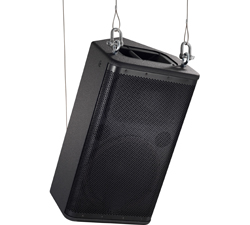Excerpted from JBL Professional Technical Note Volume 1, Number 14: “Basic Principles for Suspending Loudspeaker Systems.”
Design Factor
Design factor is a term used by the rigging industry to denote theoretical reserve capability.
The rated capacity / of all lifting and hanging equipment b based upon the nominal strength of the equipment reduced by the design factor.
Design factor is a number representing the fraction of equipment nominal strength chosen to be appropriate for the particular application.
Rated Capacity = Nominal Strength / Design Factor
Example: Design factor = 5. The rated capacity of equipment is only l/5 of its nominal strength.
Minimum design factors vary according to the application, and may be regulated from location-to-location.
No design factor discussed herein should be assumed to represent a recommendation on the part of JBL.
Users must assume all responsibility for the determination of design factors suitable for local conditions.
Shock Loading
When a load is suddenly moved or stopped, its weight may be magnified many times the original value. This is known as shock loading. Shock loading of lifting equipment should be avoided at all times.
Shock loads will usually be instantaneous and may go undetected unless equipment is visibly damaged. No equipment is designed to compensate for poor rigging practices or foolish planning, however.
Every tool and piece of equipment has limitations. Safe working practices demand that these limitations he known and fully understood, and that they never be intentionally exceeded.
A 900 pound loudspeaker cluster dropped four inches cod cause a shock load of 4500 pounds if the rigging were attached to rigid structures and of a material that would not stretch.
However, because all rigging will stretch under shock loading, the exact shock load on a piece of equipment isn’t easily predicted.
To protect people and property, all tools and equipment should be limited to stresses that are several times smaller than their minimum breaking strengths.
Although shock loading of equipment and structure is usually confined to lifting and installation, it should also be recognized that other forces (such as earthquakes) can impose shock loads upon structures many times that of the static load.
It is therefore imperative that hardware and structures be capable of supporting several times the weight of the equipment being hung.
Center of Gravity
The center of gravity of an object is the point at which the weight of the object acts as though it were concentrated. It is the point at which the object may be completely supported or balanced by a single force.
The center of gravity of a regularly shaped object may be estimated fairly accurately by determining its approximate center.
Finding the center of gravity of irregularly-shaped objects can be more difficult, but it is necessary, nevertheless. A load will always hang from its attachment point through the center of gravity. It is important to visualize this before making a lift.
All loads to be lifted should be rigged above the center of gravity in order to prevent tipping and possible hazards to equipment and workers. The lifting force should always be located above the center of gravity and exert a straight vertical pull to prevent swinging of the load.















